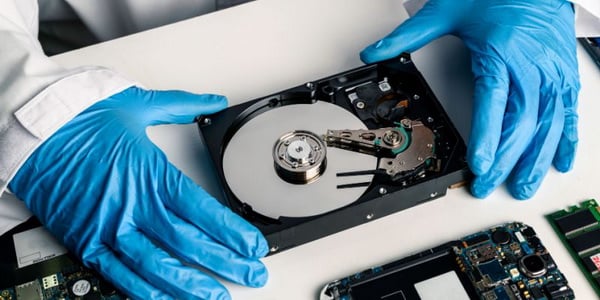1. Introduction
In today’s digital age, data forms the backbone of our lives in ways both conspicuous and subtle. From irreplaceable family photos to vital business documents, our data often holds emotional, professional, and financial value. Imagine the sudden realization that some of your important files are missing—whether due to accidental deletion, hardware failure, or other reasons. That’s where the crucial process of data recovery comes into play.
Contrary to the illusion of permanence that digital data often provides, it’s surprisingly vulnerable to loss due to multiple factors that we’ll explore later in this article. Knowing how to recover from such setbacks is not only wise but often essential. Various software and hardware solutions can help in data recovery, and understanding how they work will better equip you for the unexpected.
2. What is Data Recovery?
Data recovery, in its most basic form, is the process of retrieving lost, deleted, or inaccessible data from different types of digital storage devices. These devices can range from traditional Hard Disk Drives (HDDs) and Solid State Drives (SSDs) to more portable options like USB flash drives, memory cards, and DVD-ROMs. In some cases, even cloud storage solutions may require data recovery solutions if data becomes corrupted or inaccessible.
2. 1 Types of Data
When we refer to “data,” it’s a broad term that encompasses various kinds of information. You could be dealing with text documents, spreadsheets, photos, audio files, videos, or complex databases. Each of these forms of data has its own set of formats and algorithms for recovery, making the process highly specialized depending on what exactly you’re trying to recover.
2.2 Storage Devices
Data is typically stored on physical devices like HDDs and SSDs, but it can also exist on network-attached storage (NAS) systems or even virtual cloud servers. Understanding the type of storage involved is crucial in choosing the appropriate data recovery technique. For instance, SSDs use NAND-based flash memory, which requires different recovery approaches compared to the magnetic storage in HDDs.
2.3 Levels of Complexity
Data recovery isn’t a one-size-fits-all procedure. It can be as simple as restoring a file from the Recycle Bin or as complex as reconstructing corrupted data through specialized software. The level of complexity involved in data recovery often depends on many factors. Below are the most important ones:
- The cause of the data loss, which could range from simple human error to mechanical failure or even cyber attacks.
- The file format. It is much easier to recover a simple plain text file than a complex Word document with various formattings, images, and different objects.
- The file system. The file system determines the data structure the operating system uses to store the files. A File Allocation Table (FAT) system is much simpler than a New Technology File System (NTFS).
2.4 Extent of Recovery
Finally, it’s important to note that not all data recovery efforts yield the same results. While some instances allow for complete and successful retrieval of data, others may result in only partial or failed recovery. Factors such as the severity of the data loss, the time elapsed since the data was lost, and the steps taken immediately after the loss can significantly impact the success of data recovery efforts.
3. Common Causes of Data Loss
Data loss is an unfortunate event that can occur due to a myriad of reasons. Understanding the root cause of data loss is crucial for effective data recovery and future prevention. Below are some common culprits behind the disappearance or inaccessibility of data.
3.1 Hardware Failure
One of the most common causes of data loss is hardware failure. This can range from a complete breakdown of a hard drive to smaller, less noticeable issues like bad sectors. Hardware failures often require specialized equipment and expertise for data recovery and are usually not something that can be fixed with DIY solutions.
3.2 Software Corruption
Software corruption is another prevalent reason behind data loss. Whether it’s the operating system crashing, a specific application failing to work correctly, or a power failure, software issues can make data inaccessible. In such cases, data recovery efforts may involve using specialized software to repair the corruption or retrieve the data.
3.3 Human Error
Perhaps the most avoidable yet frequent cause of data loss is human error. Accidental deletion, formatting the wrong drive, or even unplugging a device incorrectly can result in data becoming lost or corrupted. Fortunately, data lost due to human error is often easier to recover than data lost for technical reasons.
3.4 Natural Disasters
Although less common, natural disasters like floods, fires, and earthquakes can also cause data loss. In these extreme cases, the physical storage media is often severely damaged, making data recovery particularly challenging. It emphasizes the importance of having a robust backup strategy that includes off-site storage.
3.5 Viruses and Malware
Cyber threats like viruses and malware can corrupt files, steal sensitive data, or even wipe entire drives. Protective measures like firewalls and antivirus software can help prevent such attacks, but once data is affected, specialized software or professional services are typically needed for recovery.
Understanding the various causes of data loss allows for more targeted and effective data recovery strategies. It also highlights the importance of preventive measures, including regular backups and robust security protocols.
4. Types of Data Recovery
Data recovery isn’t a monolithic process but rather a multifaceted endeavor that varies based on the nature of the data loss and the type of storage device involved. This section delves into the different types of data recovery techniques commonly employed.
4.1 Hardware Recovery
When hardware components like the read/write heads, motors, or storage platters in a hard disk drive fail, mechanical or physical recovery is required. This is a highly specialized process often performed in cleanroom environments to avoid further data corruption. The aim is to retrieve as much data as possible from faulty hardware.
4.2 Logical Recovery
Logical data recovery deals with data loss situations where the hardware is functioning correctly, but the data is still inaccessible. This could be due to accidental deletion, formatting, or software corruption. Logical recovery typically employs software tools that can do one of the following tasks:
- Scan the storage media or file system for ‘lost’ data and restore it, making it one of the more straightforward forms of data recovery.
- Scan the corrupt or damaged files and recover data in them. This is also called file recovery. Normally for different file formats, you need to employ different file recovery software products. For example, for Outlook PST files, you need to use Outlook Repair tools, for SQL Server Database files, you need to use SQL Server Recovery tools, and so on.
- A combination of 1 and 2.
4.3 Advanced Techniques
Besides the more traditional forms of data recovery, some advanced techniques involve complex processes like data carving or file system journaling. Data carving is the practice of identifying and retrieving files from raw data, like the task 3 mentioned above, whereas file system journaling involves analyzing file system logs to revert changes and restore lost data.
Data recovery can be a complicated and nuanced process that relies on a variety of methods tailored to specific situations. Whether it’s the use of advanced software, hardware repairs, or other specialized techniques, the ultimate goal is the retrieval of lost or inaccessible data.
5. Data Recovery Techniques
While there are different types of data recovery based on the nature of the data loss, the actual techniques used for retrieving this lost or corrupted data can be varied. This section highlights some of the commonly employed techniques in the field of data recovery.
5.1 Disk Imaging
In cases involving failing hardware or bad sectors, disk imaging can be a lifesaver. This technique involves creating an exact replica of the storage device, essentially making a bit-by-bit copy. Recovery efforts are then conducted on this image, preserving the original data and preventing further hardware wear during the recovery process.
5.2 Software Solutions
Various specialized software tools exist for different types of data recovery, such as logical recovery or encrypted file retrieval. These software solutions usually provide user-friendly interfaces that guide users through the recovery process, making it accessible even to those who aren’t tech-savvy.
5.3 Data Carving
Data carving is an advanced technique used primarily when file systems are too damaged to recover. This method sifts through the raw data byte by byte, identifying patterns that correspond to known file types. It’s particularly useful when standard metadata like file tables are corrupted or missing, making traditional recovery methods ineffective.
5.4 File System Journaling
File system journaling is a technique employed in certain types of file systems like NTFS and ext4, where changes to files and directories are logged. In case of a failure or corruption, these logs can be analyzed to restore the file system to a stable state, making it a useful technique for recovering lost data after software corruption or system crashes.
Understanding the range of techniques available for data recovery can help in selecting the most appropriate method for your particular situation. While some techniques are suitable for DIY recovery, others are complex enough to require specialized training and equipment.
6. DIY vs. Professional Data Recovery
The choice between attempting data recovery yourself and seeking professional help can be challenging. Each option has its merits and drawbacks, depending on the circumstances surrounding the data loss.
6.1 When to Attempt DIY Recovery
For relatively straightforward cases of data loss, such as accidental deletion or minor software issues, attempting a DIY recovery could be sufficient. Several reliable data recovery software tools are available on the market for such cases. These tools usually come with user-friendly interfaces and step-by-step guides, making it possible for those without specialized knowledge to retrieve their data.
6.2 Risks of DIY Data Recovery
However, DIY data recovery is not without its risks. For instance, if you’re dealing with failing hardware, trying to recover the data yourself might worsen the situation and make subsequent professional recovery attempts more difficult or even impossible. Moreover, improper use of data recovery software can lead to permanent data loss, especially if you’re unfamiliar with the recovery process.
6.3 DIY Recovery on Corrupt or Damaged Files
A good case of DIY data recovery is using software to recover corrupt or damaged files. Normally, you can back up the files before recovery, so to eliminate the risks of damaging them again and making things worse.
Also file recovery is relatively simple and does not require much expertise, so you can perform the recovery by yourself.
For example, if your SQL Server database is corrupt, you can use professional SQL Recovery tools to recover it. The whole process is as simple as select the source file, and then click the “Start” button, making the DIY recovery very simple, even to the novice.
6.4 When to Seek Professional Help
If the data loss situation involves hardware failure, complex file corruption, or if you’ve attempted DIY recovery without success, it’s time to consult professionals. They have the specialized equipment and expertise needed to handle more complex cases and can maximize the chances of successful data recovery.
6.5 The Expense of Professional Services
While professional data recovery services can be costly, they offer the best chance of retrieving your data in complicated scenarios. Therefore, the expense is often justified, especially when the data in question is invaluable or crucial for business operations.
In summary, whether to opt for DIY recovery or professional services largely depends on the complexity of the data loss scenario and the value of the data in question. Choosing the right course of action is vital in optimizing your chances of successful data recovery.
7. Preventive Measures and Best Practices
Preventing data loss is always better than trying to recover data after the fact. Though data recovery techniques have come a long way, there are no guarantees of complete data retrieval. This section focuses on preventive measures and best practices that can help mitigate the risk of data loss.
7. 1 Regular Backups
One of the simplest yet most effective ways to prevent data loss is by maintaining regular backups. Whether you choose cloud-based storage solutions or physical storage devices like external hard drives, having a backup allows you to restore data quickly if loss occurs.
7.2 Updated Security Measures
In a world where cyber threats are increasingly common, keeping your security measures updated is crucial. Employ robust firewalls and regularly updated antivirus software to protect against malware and other security threats that could result in data loss.
7.3 Safe Hardware Practices
Safe usage and maintenance of hardware can also go a long way in preventing data loss. For instance, protect your devices from physical damage, keep them in optimal operating conditions, and shut down systems properly to avoid any chances of hardware-related data loss.
7.4 Data Auditing and Monitoring
Implementing data auditing and monitoring solutions can alert you to any unusual activity or potential issues that could lead to data loss. These systems can provide real-time alerts, giving you the chance to act before significant data loss occurs.
Understanding and implementing these preventive measures and best practices can significantly reduce the risk of facing a data loss situation. While no strategy can offer a 100% guarantee against data loss, these methods can greatly mitigate the risks and offer you peace of mind.
8. The Future of Data Recovery
As technology continues to evolve, so does the field of data recovery. With increasing amounts of data being generated and stored, the importance of effective recovery solutions cannot be overstated. This section explores what the future holds for data recovery.
8.1 Artificial Intelligence and Machine Learning
The integration of Artificial Intelligence (AI) and Machine Learning (ML) into data recovery solutions is a burgeoning trend. These technologies can analyze vast amounts of data quickly and accurately, offering the potential for more efficient and successful recovery efforts. They could automate the detection of data loss events and even initiate preliminary recovery processes autonomously.
8.2 Cloud-Based Recovery
As more organizations move to cloud-based storage solutions, the need for cloud-specific recovery methods is increasing. Future data recovery tools may focus on efficient ways to retrieve lost data from cloud environments, possibly incorporating features like real-time syncing and automated backups to ensure minimal data loss.
8.3 Data Recovery as a Service (DRaaS)
The concept of Data Recovery as a Service (DRaaS) is gaining traction. This model allows businesses to outsource their data recovery needs to specialized providers, ensuring high levels of expertise and cutting-edge technology are employed in recovery efforts.
8.4 Security Concerns
As data recovery techniques evolve, so do the methods employed by cybercriminals. Future developments in data recovery will likely focus heavily on security features to protect against unauthorized data retrieval, thereby aligning data recovery and cybersecurity more closely than ever before.
The landscape of data recovery is ever-changing, and staying abreast of new trends and technologies can better prepare you for unforeseen data loss events. While the core principles of data recovery remain consistent, the tools and methods employed are in a constant state of evolution, making it an exciting field to watch.
9. Conclusion and Final Thoughts
The realm of data recovery is complex, dynamic, and critically important in our increasingly digital world. Whether it’s a simple act of accidentally deleting a file or a more severe case involving mechanical failure of a hard drive, data loss is a problem that most will encounter at some point.
9.1 Importance of Understanding Data Recovery
Understanding the nuances of data recovery not only prepares you for the unfortunate event of data loss but also allows you to implement preventive measures. Knowledge in this field equips you with the tools to make informed decisions, whether it’s selecting appropriate backup solutions or choosing between DIY recovery and professional services.
9.2 Choose Wisely: DIY or Professional Services
Remember, the decision between attempting DIY recovery and seeking professional help can be critical. It hinges on the complexity of the data loss situation and the value you place on the lost data. A wrong move could lead to permanent data loss, underscoring the importance of making informed decisions.
9.3 Keep an Eye on Future Trends
As technology evolves, so will data recovery techniques and tools. Being aware of emerging trends like AI integration, cloud-based recovery, and DRaaS can give you an edge in dealing with future data loss scenarios. These advances promise to make data recovery more efficient and secure, albeit with new challenges.
9.4 Final Takeaway
In conclusion, data recovery is an indispensable aspect of our digital lives. Its principles and practices intersect with various facets of technology, from hardware and software engineering to cybersecurity. By understanding its intricacies, you arm yourself with essential knowledge that could prove invaluable in a time of crisis.
Author Introduction:
Vera Chen is a data recovery expert in DataNumen, Inc., which is the world leader in data recovery technologies. For more information visit www.datanumen.com



